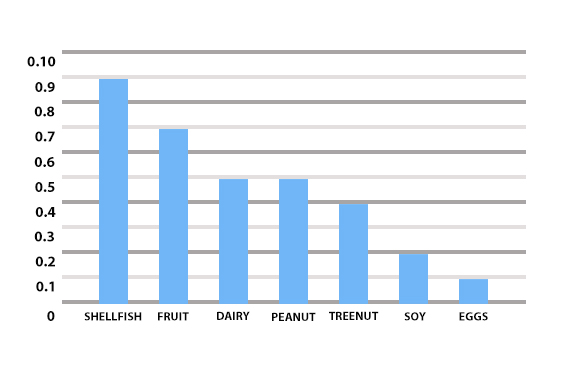
Welcome to “Baby Food Allergies Symptoms” – the guide where we will navigate through the sometimes bumpy road of introducing baby food with as much grace and humor as we can. It’s rather like sitting down for a chat with your go-to friend who has been there, done that and is here to share both wisdom and some much-needed laughs.
Ah! The world of baby food! One minute, you’re watching your little one taste pureed carrots for the first time, and next thing, you are wondering whether that funny face they made means something more serious than “Eww, veggies!” Spoiler: Babies have got a flair for dramatic faces.
Understanding food allergies in babies can feel like a high-stakes detective mission. You’ve got the clues (cue mystery music), but what do they mean? Is that rash from strawberries or is it just because babies love to surprise us with new reactions? And what’s up with those tiny red spots that appear just about when you are ready to pat yourself on the back for being a perfect parent?
In this friendly guide we’ll be looking at symptoms of food allergens in infants, sharing real life stories (because let’s face it; we have all had those moments when we ask ourselves if it’s an allergy or just weirdness on this baby) and arming you with enough knowledge to keep your little human safe and happy.
So take deep breaths, grab a cup of chamomile tea—soothing for both mommy and baby—and jump into the fascinating though confusing universe of baby food allergy. At the end of our conversation, you will become adept at recognizing symptoms like a pro while having some hilarious moments to remind yourself that you are indeed super-parent!
Ready to become the ultimate baby food detective? Let’s get started!
Parents love to feed their baby with solid foods, but there is a problem called food allergies can cause serious and even deadly reactions to the kids. So it’s very important for the parents to know what the baby food allergies symptoms are and what food causes allergies in babies.
Gradually, every parent should have to introduce a baby with new foods, one at a time. Because, if they give their baby three new foods over the course of a day, then the kids can be affected by food allergic reaction and their parents will not able to identify which of the food is responsible for it. If they really want to add new item with their kids menu, then they should wait 3-5 days before adding it.
Food allergies in babies can manifest in various symptoms, and it’s important for parents and caregivers to be aware of them. Keep in mind that if you suspect your baby has a food allergy, it’s crucial to consult with a healthcare professional for proper diagnosis and guidance.
Top allergenic foods for babies
These types of food are the top allergenic foods for babies, because 90% of the time these following foods are responsible to create allergic reactions.
- Eggs
- Milk dairy such as Cow’s Milk Protein or CMP
- Peanuts
- Tree nuts such as walnuts, pecans, almonds etc.
- Fish such as flounder, cod, bass etc.
- Crustacean shellfish for instance crab, lobster, shrimp etc.
- Wheat gluten allergy
- Soybean
The most common food allergen groups were:
Shellfish-0.9%
Fruit or vegetable-0.7%
Dairy-0.5%
Peanut-0.5%
Baby food allergies symptoms:
Usually, food allergy symptom appear very soon after eating the foods, it can be happened within a few minutes to a couple of hours. So, when you introduce your baby with a new food, then you should have to keep an eye out for these symptoms:
Stomach and digestive tract symptoms
- Vomiting
- Diarrhea
- Stomach cramps
Respiratory problem
- Wheezing
- Repetitive cough
- A runny nose or blocked nose
- Swelling of the face, eyes, tongue, or lips which affecting the ability to talk or breathe
Severe, full-body reactions (Anaphylaxis)
- Dizziness or feeling faint
- Lightheadness
- Loss of consciousness
- Shortness of breath
- Rashes around the face and the body
Skin Reactions
- Pale or blue coloring skin
- Hives or welts raised, red, itchy bumps on the skin
Other reactions
- Weak pulse
- Itchy and red eyes
- Nasal congestion
- Shock or circulatory collapse
- Tight throat, hoarse voice
- Constipation
- Anaphylaxis
- Watery eyes
It’s important to note that some symptoms may be immediate, occurring shortly after consuming the allergen, while others may be delayed and appear hours later. Anaphylaxis is a severe and potentially life-threatening allergic reaction that can involve a combination of symptoms, including difficulty breathing, a rapid drop in blood pressure, and loss of consciousness. If you suspect anaphylaxis, seek emergency medical attention immediately.
Common food allergens in babies include cow’s milk, eggs, peanuts, tree nuts, soy, wheat, fish, and shellfish. Introducing new foods one at a time and observing your baby for any adverse reactions can help identify potential allergies. If you suspect a food allergy, consult with a pediatrician or allergist for proper testing and guidance on managing your baby’s diet.


